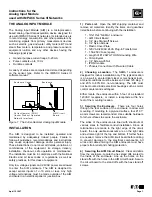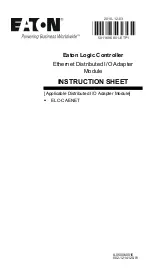
36
DHOLLANDIA
10.3
MOUNT THE END STOPS FOR THE WORK POSITION
•
On sliding liftgates, the work position of the platform at the loading
floor of the vehicle is determined by:
1.
The end stops for the lift arms or platform (type and position)
2.
The end stops for the retraction movement in the sliding tubes
Both points need to be considered together to obtain optimum
results.
•
Most platforms are equipped with PVC buffers at the front edge which
are designed to press against the rear cross member of the loading
floor of the vehicle. [Figure 10.9]
•
If the loading floor of the vehicle does not allow this, an alternative is
to fit the end stops to the chassis or vehicle body, against which the
lift arms can be pressurized [see Figure 10.10 for examples].
•
Make sure that the arm stops are sufficiently strong to sustain the
force induced by the lift cylinders at maximum oil pressure, and to
work correctly through the expected lifetime of the liftgate.
•
For mounting situations where there is a wide gap between the loading floor of the vehicle and the platform in work position, a bridge
plate (option S241) can be used [see Figure 10.11].
•
The same bridge plate can also be used on container chassis to adapt the platform to varying container sizes and positions.
•
2 end stops at the rear of the sliding tubes ensure that the platform
assumes the same stable work position every time the liftgate is
used. [1 in Figure 10.15]
•
Lift the platform up to the loading floor of the vehicle and set it in its
intended work position as explained above. [Figure 10.15]
•
Insert the end stops [1 in Figure 10.15] in the sliding tubes. Move
them to the work position of the slide plates in the sliding tubes.
Fasten the locking bolt of the end stops to the required torque
settings.
•
Slide the liftgate in and out several times to verify if the platform
assumes the correct work position at the loading floor of the vehicle.
Fine tune the position of the end stops if required.
NOTICE
Technical details on end stops, platform buffers, etc… may differ between various types of sliding tubes. The images under th
is
paragraph are merely examples. Please refer to the appendixes for detailed information.
Figure 10.9
Figure 10.10
Figure 10.11
⚠
⚠
⚠
⚠
Содержание DH-S Series
Страница 11: ...10 DHOLLANDIA 1 2 3 4 5 6 7 8 9 10 11 12 14 15 16 17 13 Figure 6 1...
Страница 13: ...12 DHOLLANDIA Figure 6 2...
Страница 46: ...45 DHOLLANDIA Figure 11 6 Figure 11 8 Figure 11 7...
Страница 49: ...48 DHOLLANDIA...
Страница 50: ...49 DHOLLANDIA...
Страница 66: ...65 DHOLLANDIA Figure 16 4...
Страница 68: ...67 DHOLLANDIA For option OAE510 15 see Figure 16 6 below Figure 16 6...
Страница 73: ...72 DHOLLANDIA...
Страница 74: ...73 DHOLLANDIA...
Страница 75: ...74 DHOLLANDIA...
Страница 76: ...75 DHOLLANDIA...
Страница 77: ...76 DHOLLANDIA...
Страница 78: ...77 DHOLLANDIA...
Страница 80: ...79 DHOLLANDIA 16 9 MOUNTING DIAGRAMS...
Страница 81: ...80 DHOLLANDIA...
















































